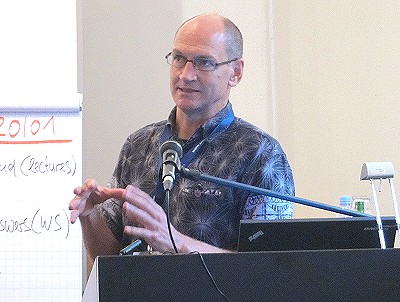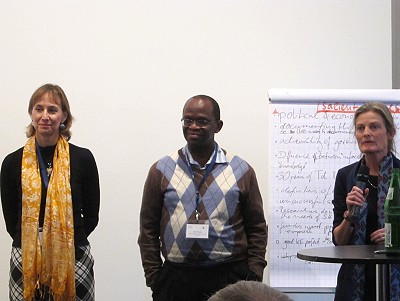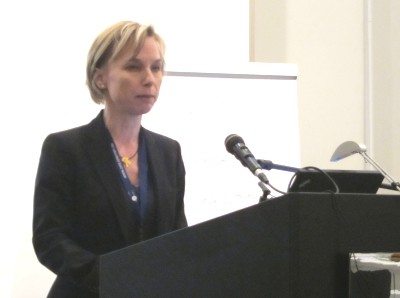Annotations to the 1st ZMT Workshop on Science for Sustainability – The Contribution of Transdisciplinary Knowledge Exchange, Bremen, Germany, 19-21 January 2015
by Cornelia E Nauen, Mundus maris
 The annual world-wide investment into research exceeds the national budgets of most countries. In the face of growing social inequalities and dangerous ecological overshoot it calls the question of what happens in the process. What questions are being addressed, whose knowledge counts, how results can be made more useful to humanity.
The annual world-wide investment into research exceeds the national budgets of most countries. In the face of growing social inequalities and dangerous ecological overshoot it calls the question of what happens in the process. What questions are being addressed, whose knowledge counts, how results can be made more useful to humanity.
This is heady stuff that has fired up debates not only about the capacity for the production of scientific knowledge, but also about sharing it more effectively. That also puts into focus how to structure and retrieve such knowledge so as to facilitate its assimilation and use. How does scientific knowledge relate to other forms of making sense of the world? These questions become more intense in the context of sustainability science. In its most extensive interpretation, sustainability science explicitly attempts to draw in a wide spectrum of disciplinary science - as well as e.g. tacit and traditional knowledge – and engages critically with all actors in society in the quest to help us live dignified lives within the regenerative capacity of planet earth.
Dr Bevis Fedder, responsible for knowledge management at the Leibniz Centre for Tropical Marine Ecology (ZMT) in Bremen, had organised the workshop to start coming to grips with these issues. It focused on transdisciplinary knowledge exchange.
The first two days were heavy on presentations of senior scientists and research managers from different parts of the world, interspersed with break out sessions in smaller groups. The third day was entirely reserved for interactive working group sessions and exchange.
The most inspiring presentations came from scientists or science managers working outside or the margin of big established research institutions. They all recognised the deeply collaborative nature of knowledge production and use. Two presentations serve as examples of practicing critically engaged science adapted to their respective context.
An interesting example of successful science engagement in the Pacific
Dr Hugh Govan reported on experience with implementing a relatively novel strategy of supporting community resource management in small island developing states in the Pacific. Coastal and off-shore fisheries are of great importance to island economies. In decreasing order they matter for nutrition and food security, for GDP and for government revenue. Overexploitation of commercial invertebrate fisheries are causes for concern, particularly in populous Melanesia (close to 9 million people). Think e.g. of moratoria now in place for sea cucumbers (bêche-de-mer). Four out of five communities are expected to fall short of their needs by 2030 if current trends continue unabated. Communities are predominantly rural. Yet, most development money went into offshore fishing, which contributes little to the national economy. But offshore fishing by foreigners generates much of the government's income other than aid, even if the licencing captures only a small fraction of the resource value. Given the, at best modest, ability of governments to ensure services and management of their vast distributed territories, community based management is the most realistic option.
 Recognising this reality was the first step towards supporting communities through promoting coastal resource management, learning what works and why, building capacity and developing favourable policies. In order to take well-targeted action, the network members determined that decision makers were mostly fishers and their communities rather than administrations in the capital city. These communities view the inshore fisheries predominantly through the lense of livelihoods and local problem solving in the community. The most useful type of information for them integrated existing marine and land tenure practices into consensus-building around a adaptive local fisheries management plan. The plans revolved around zoning and gear and access restrictions, among others, rather than a blanket closure which might have been impossible to enforce. Each community assessed where the biggest challenges were, what options they had and then built social consensus around adoption and enforcement. The final step in the cycle was to check whether it was working or in need of adjustments.
Recognising this reality was the first step towards supporting communities through promoting coastal resource management, learning what works and why, building capacity and developing favourable policies. In order to take well-targeted action, the network members determined that decision makers were mostly fishers and their communities rather than administrations in the capital city. These communities view the inshore fisheries predominantly through the lense of livelihoods and local problem solving in the community. The most useful type of information for them integrated existing marine and land tenure practices into consensus-building around a adaptive local fisheries management plan. The plans revolved around zoning and gear and access restrictions, among others, rather than a blanket closure which might have been impossible to enforce. Each community assessed where the biggest challenges were, what options they had and then built social consensus around adoption and enforcement. The final step in the cycle was to check whether it was working or in need of adjustments.
True to honouring local traditions, such local community management plans get endorsement through a sacrifical pig and the declaration of a tabu rather than the signing of a formal contract. Rapid uptake from a few to more than 600 in a short time-span is believed to be in no small manner helped by exactly that respect and modernisation of deep rooted traditions. A non-sectoral approach is also suited to serve multiple purposes in a community and make use of opportunities afforded by at least some project support. The concepts even expanded into the Western Indian Ocean and new places in the Pacific, including to communities where project and science support was not available. Very few have any formal legal basis.
Huge challenges remain all the same as the number of communities in the Pacific is estimated to be in the order of 10,000 and it is difficult to conceive that governments could provide a costly information and support service to each and everyone of them even though at national and regional levels community-based co-management is the official policy discourse. It is thus worth reflecting on how research, provision of information and other support to community management can be expanded in an ever more cost effective way, including perhaps through social media and distance training. As personnel and travel costs are the biggest budget positions in supporting management, joining forces e.g. with agricultural extension services, disaster relief and others are also promising avenues for delivery of support. The Secretariat of the Pacific Community (SPC) has already produced some fact sheets for key species and ecosystem features and other information material ready for use. Hugh's powerpoint presentation can be downloaded here.
Bringing science to communities in South Africa
Dr. Judy Mann of the South African Association of Marine Biological Research (SAAMBR) in Durban gave a passionate talk about the challenges of bringing marine science to different communities in the country. SAAMBR is a non-profit organisation with a staff of about 200. Its objective is to help people to care about the ocean. It pursues its goal against the backdrop of about 32% of the 52 million strong population below age 15, 25% unemployed and 10% HIV positive citizens.
 The three major thrusts of its work are the aquarium, curriculum linked education and wider capacity building particularly in subsistence fishing communities.
The three major thrusts of its work are the aquarium, curriculum linked education and wider capacity building particularly in subsistence fishing communities.
The uShaka Sea World aquarium attracts upwards of 800,000 visitors a year and is the major source of income for all of SAAMBR's research and extension work. The aquarium inspires visitors through the wonders of life underwater and aims to instill a sense of care for the ocean and its creatures. It truly wants to connect people's lives to the ocean and empower personal and group action for its protection.
While some 100,000 pupils visit the aquarium every year, SAAMBR's focus is on supporting teachers so that they can be more effective go-betweens for the young people and their discovery of the ocean. The organisation pays special attention to reaching out to rural communities, who may not have much first hand exposure to the sea.
As many recent fishing communities have neither traditions nor historically grown traditional authorities, they have little or no traditional knowledge about the sea and hardly any understanding why regulations exist. Helping their empowerment so that they can be actors in co-management of the resource also needs better relationships between the government's resource managers and rangers and these communities.
After years of effort, commercial and recreational fishermen show signs of changing attitudes and increase compliance with regulations. But there is no reason to become complacent.
Genuine two-way exchanges and building personal relationships have worked best in creating trust and willingness to listen to one another. Presentations, radio and tv have proven helpful for sharing information.
Providing scientific advice to local environment managers is crucial support as local capacity for law enforcement for the Marine Living Resources Act (1992-94) and the Integrated Coastal Management Act (2000-2008) is minimal. SAAMBR has also extended scientific advice to coastal communities in Mozambique, Tanzania, Kenya and Somalia, but its major focus remains in South Africa.
A recent focus of work is to work with magistrates, prosecutors and judges. These professions are confronted with the high levels of violent crimes on a daily basis and thus do not traditionally consider environmental crimes a priority. Exchanging information with judges, serving as expert witnesses and supplying data to other researchers are all becoming more common to get more people excited about protecting the ocean.
These different fields of work have one question as common denominator: How do people learn? SAAMBR's work clearly indicates that more information per se does not change people's attitudes and actions. What does bring about change is personalised information and support to making sense of the world. It's the passion that helps learning and seeing and participating in activities makes people reflect. When information consists of a problem description, it should be complemented by suggestions of what can be done about it. Without such suggestions, remedial action might not be self-evident or come spontaneously.
A space for productive exchange and exploration of new science-society relations
 ZMT had invited an interesting range of speakers to share their reflections and experiences on the new ways in which sustainability science needs to engage with societal issues and actors.
ZMT had invited an interesting range of speakers to share their reflections and experiences on the new ways in which sustainability science needs to engage with societal issues and actors.
Listening to their quite different perspectives the research institutions' need became clearer to go well beyond the comfort zone of publishing results in the primary literature and seeking recognition from peers. A series of break-out sessions and other more interactive parts of the workshop created a space for self-reflection and search of pathways.
From the many issues identified by participants, a collective priority setting homed in on a few challenges considered particularly crucial to improve knowledge exchange and co-creation. An eminent panel then commented on these priority topics and engaged the audience in the debate. The panel was composed of Prof. Klaus Töpfer, Executive Director of the Institute for Advanced Sustainability Studies in Potsdam and former Executive Director of the UN Environment Programme in Nairobi, Dr. Hamady Diop, Director of Research and Innovation Systems of the West African Sub-Regional Fisheries Commission, and Alfred Schumm, Leader of the Global Fisheries Programme of WWF.
The growing numbers of not for profit knowledge institutions outside traditional universities and research institutes are a good indication for new needs critical engagement of scientists becoming stronger. The ZMT workshop offered a much needed exchange platform.
Several systemic features in the conventional science system provide powerful obstacles to sustainability science and its need to engage with all actors in society from the beginning of the knowledge production and sharing process. It starts with the need to produce researchable questions out of a dialogue process with others, including non-scientists, in the understanding that different perspectives often generate more interesting questions.
But recognition of such interactive research methods is not yet part of the career criteria and impact factor assessments. Learning to express research questions in a wider context and in understandable language to the many so as to facilitate testing and uptake is not yet part of basic study programmes. And research funders care primarily about publications in top journals, while research capacity building and outreach to groups in society, especially those outside “big business” are not prioritised.
 Yet, leading scientists of their day have taken great care to make their research understandable to the many. One of the inspiring role models is Sir Peter Medawar, the Nobel Prize winning biologist. "He was also awarded the 1987 Michael Faraday Prize "for the contribution his books had made in presenting to the public, and to scientists themselves, the intellectual nature and the essential humanity of pursuing science at the highest level and the part it played in our modern culture"." (quoted from Wikipedia).
Yet, leading scientists of their day have taken great care to make their research understandable to the many. One of the inspiring role models is Sir Peter Medawar, the Nobel Prize winning biologist. "He was also awarded the 1987 Michael Faraday Prize "for the contribution his books had made in presenting to the public, and to scientists themselves, the intellectual nature and the essential humanity of pursuing science at the highest level and the part it played in our modern culture"." (quoted from Wikipedia).
Today, there are more shining examples of how to reach out to citizens and also enrich the research process through systematic exposure to the “wisdom of crowds”. The workshop was one more step on the long road to mainstreaming this way of doing science.
The workshop programme is available here. More information about ZMT is available on its website. The Bremen Criteria on international cooperation are here.








